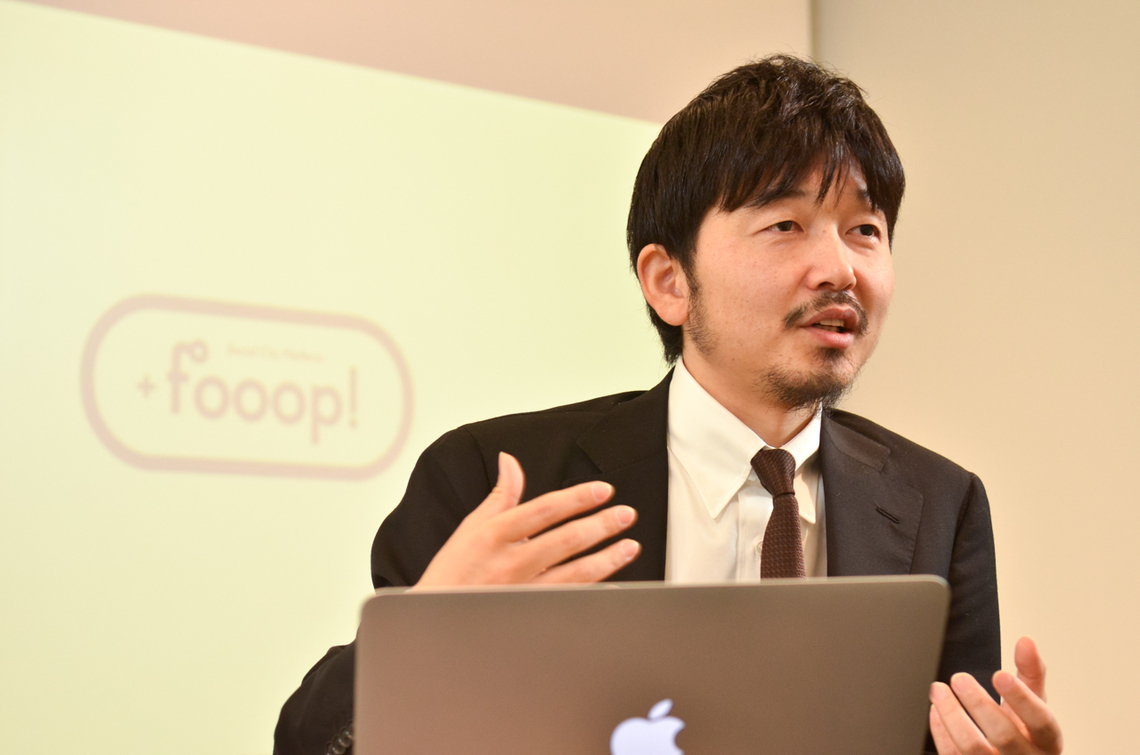Dentsu Inc. International Information Services (ISID)'s Open Innovation Lab (Inolab) is currently challenging itself to create an entirely new kind of town using IT. The entire town is connected by a single IT platform, constantly updated daily through vast amounts of data gathered using NFC (Near Field Communication) and location-based systems...
We spoke with Junichi Suzuki, an InnoLab researcher and the mastermind behind this "ever-evolving city," to learn more.

A completely new approach to city development, starting with exploring the use of NFC and positioning technologies
――What exactly do you do at INOLAB, Mr. Suzuki?
Suzuki: I research town development through IT utilization. Originally, I worked in ISID's Financial Services Division, building systems for financial institutions. But I suddenly realized we'd entered an era where non-financial businesses were offering various electronic money and point services... I thought financial services provided by non-financial institutions would become increasingly widespread. I sensed a future where businesses like railway companies and manufacturers would use finance-linked technology to form alliances with other companies and transform service content. That's when I thought, "Then we should also leverage the technical expertise we've cultivated in financial services to develop offerings for a broad range of customers, not just financial institutions."
――How are RFID and NFC technologies used in electronic money services related to urban development?
Suzuki: Initially, IC cards issued by general businesses were used solely as payment methods for electronic money or points. However, as technologies like RFID (Radio Frequency Identification) and NFC (Near Field Communication) became widespread, they also began functioning as authentication methods for identifying individuals and as tools for cross-promotion between businesses. For instance, you can now buy age-restricted items like cigarettes simply by tapping your card, or have movie tickets issued upon personal recognition. Furthermore, by having customers "tap" their card or smartphone on terminals installed at stores or tourist spots, it became possible to capture consumption history—like what was purchased at which store—and behavioral history, such as where someone went and when. Additionally, by linking RFID or NFC—which serve as real-world IDs—to social media accounts, it's possible to determine who someone was with, using tag information and other data.
Leveraging this data reveals even "human relationships" – like how many friends an NFC-equipped individual has and the influence they hold over specific people. This enables stores and regions to provide more personalized, satisfying services. Starting with payment functionality, alliance strategies aimed at mutual customer referrals could transform service models and create new urban forms.
What is the world's first social city, "Grand Front Osaka"?
――"Grand Front Osaka," which opened in April 2013, is attracting attention as a new town leveraging IT, right? I hear ISID is responsible for its IT infrastructure. What kind of town is this exactly?
Suzuki: "Grand Front Osaka" is a large-scale complex directly connected to JR Osaka Station. Spanning a vast 7-hectare site, it integrates shopping malls, restaurants, offices, theaters, and hotels, attracting many visitors since opening. A particularly distinctive feature is "Knowledge Capital," a hub where domestic and international research institutions gather to foster "knowledge exchange." Numerous universities and companies are housed here, aiming to generate new intellectual creations through collaboration. In fact, Inolab is also located within Knowledge Capital.
This "Grand Front Osaka" is also drawing attention as the world's first social city, where the entire district adopts a single IT platform. When the project began, we participated as members of a research committee tasked with developing payment and point systems. However, ideas kept expanding: "Electronic money is convenient for payments, right? Everyone has IC cards. If we're going to manage electronic money and points, we need to support NFC, which was just starting to be considered for smartphones at the time. And the information gained from NFC personal authentication should be maximized to build a community of fans for the city..." Before long, the community-focused urban development vision of Grand Front Osaka—emphasizing the building of emotional connections with the city—aligned perfectly with Inolab's concept of a Social City, which aims to visualize human relationships. This alignment led us to take on the role of providing the IT infrastructure.

Aiming for an Emotional Community Where People Resonate
――What exactly is the Social City envisioned by Grand Front Osaka and Inolab?
Suzuki: It's a city nurtured by social graphs—human relationships, essentially. Smart cities are often cited as a new urban form enabled by IT, built around eco-friendly axes like visualizing electricity usage or developing transportation systems for electric vehicles. A social city, on the other hand, is more emotional. For example, consider a couple inferred from NFC history, location data, or social media activity—perhaps "these two are probably dating." If there's a product we want to recommend to the man, it might be more effective for the woman, who is likely his girlfriend, to say, "I heard that store has this great product," rather than a salesperson directly approaching him with, "This product is good for you." Social City enables messages to be delivered through this specific, influential person in the customer's life.
Consider a customer who spends around $30 per visit alone, but jumps to $100 when with a partner, and even $200 when seated by the window. Knowing this data in advance allows for thoughtful service—like offering window seats and complimentary drinks when they visit with their partner. Even in large restaurants with high foot traffic, or establishments where part-time staff constantly rotate, everyone can deliver hospitality as if welcoming a regular customer. This is precisely the unique advantage of a Social City.
We want to build a city where people resonate with each other, creating higher-quality service and new value.
(Continued in Part 5 )




